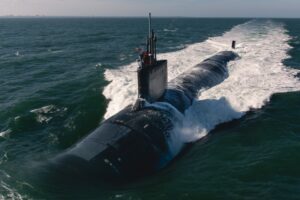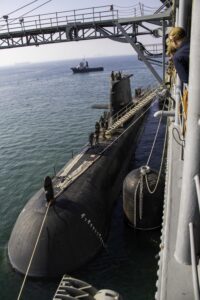Two members of the House Armed Services Committee last week revealed how they think Australia will proceed with the AUKUS submarine partnership, including buying U.S.-built nuclear reactors and having a joint U.S.-Australian command of a Virginia-class attack submarine (SSN).
Rep. Rob Wittman (R-Va.), ranking member of the House Armed Services Committee’s (HASC) Subcommittee on Seapower and Projection Forces, noted Australia has no industrial capacity to build nuclear reactors.

“That’s why I believe what will happen with this is that the United States company [BWX Technologies], which just happens to be in Lynchburg, Va., that produces those nuclear reactors will indeed produce the nuclear reactors for Australian submarines. There’s a whole back and forth about Australia’s nuclear policy and about the International Atomic Energy Commission and what their issues are with nuclear reactors there in Australia,” Wittman said during a virtual Wilson Center event on Oct. 7.
Given Australia’s laws, nuclear safety issues, nuclear security issues and non-proliferation concerns, “I think the way to do that is to just say that BWXT will produce those reactors, they’ll be shipped to Australia and their ship builders will install them in those submarines…All those things, I think, can be worked out when you have that manufacturing capability here in the United States.”
Wittman said perhaps Australia would eventually change their policy and produce nuclear reactors domestically, but believes for now the U.S. will supply nuclear reactors to Australia’s new submarine program.
The U.S., U.K. and Australia announced the AUKUS partnership over a year ago to help Australia procure a new class of nuclear-powered attack submarines to ultimately replace its current fleet of six conventional diesel-electric Collins-class submarines (Defense Daily, Sept. 15, 2021).
The process started with an 18-month exploratory review period to help Australia inform how to pursue the capability. In July, Deputy Prime Minister and Defense Minister of Australia Richard Marles said the countries hope to break down barriers for a more seamless defense industrial base through this process and the government both plans to announce its choice of submarine and fleshing out how to deal with capability gaps on the way to it in the first quarter of 2023 (Defense Daily, July 15).
This virtual event came after Wittman and Donald Norcross (D-N.J.), chairman of the HASC Subcommittee on Tactical Air and Land Forces, and also participating in the event, recently visited Australia.
Wittman argued his preferred process for transition will not start by building the first attack submarines for Australia in the U.S. since the American submarine industrial base is already stressed and needs to grow for U.S. naval requirements alone, but with a joint shared deployment in the future.
He said the U.S. is currently building about 1.4 to 1.5 submarines per year “at best, and that’s because we’re coming out of COVID.”
Wittman noted the U.S. Navy has a requirement for 54 attack submarines but the schedule of upcoming retirements and the current production rate means the service is expecting a “ bathtub” period of a lower number of attack submarines before rebounding.
“So we have to find a way for ourselves to get out of that bathtub. And when you put on top of that now having to build some additional submarines for Australia, it creates, I think, its own set of issues.”
Wittman said instead he thinks the U.S. first needs to increase the submarine pace to alternate buying two and three submarines each year. “I think we can sustain that rate of production. That gets us up to our base minimum requirement at a faster pace,” he said.

Once that production level is established, the U.S. can then do a joint deployment agreement with Australia to use one of the U.S. SSNs with Australian submariners in the Australian area of operations, jointly operated by the Royal Australian Navy and U.S. Navy.
“So we have an Australian crew on board. We have joint commanders on board, Australian and U.S., and we have the U.S. and Australia jointly command that submarine…and that way it’s still a U.S. asset while they are building capability to build their own submarine. And that way they can have the coverage that they will need as the Collins-class submarines age out and as they’re waiting for their first Australian submarine to be built.”
Wittman underscored that Australia also cannot just have the U.S. build its new submarines given domestic politics there.
“There’s a political reality that Australia has to deal with. These need to be Australian submarines. And you know, the Australians are going to look for Australians to be building those submarines. So I think we have to be careful about saying, Oh, this is going to be, you know, a U.S. effort. This has to be an Australian effort, with U.S. being the guide and being the partner there. I don’t think that we can appear as though we’re taking this over and that this is a U.S. enterprise, especially with the bathtub that we’ll go through with our own attack submarine fleet.”
Also speaking during the event, Norcross underscored developing an Australian submarine workforce is key to the AUKUS process.
“They are keenly aware of the development of a workforce to not only build, but to maintain. Now remember, they are very good in underseas operations. The nuclear capacity is something different. And let’s be sure that everybody listening understands – the most complicated machine in the history of mankind is one of our nuclear submarines. We do a great job, we have some great partners, particularly with Great Britain and that is going to be what we bring to the Aussies and they share with us. But you still need a workforce that’s able to do it,” Norcross said.
He noted the U.S. also has the related problem of building out the next generations of nuclear submarine builders in the U.S.
“So the ability to attract that next generation, not only with ourselves but with our partners in Australia, is extremely aware of and focused on…but is a matter of building the capacity they have now and growing it, which they will need through the course of the next decade.”
Wittman agreed the workforce issues are important and said it is critical to have Australian submarines train “shoulder-to-shoulder” with U.S. submariners from full training and deployment on American submarines while Australian shipbuilders need to work similarly with American builders through a full construction cycle of a Virginia-class submarine to get the right level of training.
Norcross agreed, saying “we know how we care about the workforce in our country, and they care about theirs. There are no better partners in Australia, they’re part of our five eyes. We do things with Australia, to the intelligence through our defense that few other countries could even imagine.”
“But they do want to make sure they build their capacity. I can’t tell you how many times they talked about: we’re not looking to compete, we want to compliment. Sharing the technology, sharing the workplace methods of building a nuclear sub, are a complex and long-term strategy that we will build up to. They will need to build up to that just as we are…increasing our capacity,” he added.